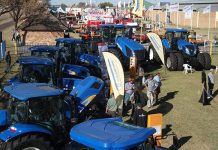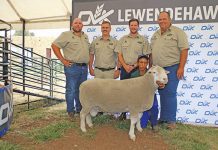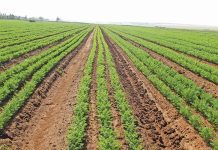It’s a common sight in Namibia – huge areas of what used to be grassland swamped by a variety of inedible invader species of bush and shrubs. The country’s arid conditions already limit the number of cattle commercial farmers can run on the land. I t’s common knowledge that a minimum of 5 000ha is needed for a viable cattle enterprise in Namibia. Most farmers south of the “red-line” veterinary fence, which divides the country in two, have farms that are far larger. M ost cattle in the commercial areas are destined for beef production, but in the past four decades the national herd has declined by over 60%.
But dwindling beef production is not the only threat posed by bush encroachment. Groundwater resources need about 6% of the average rainfall to recharge, but in bush-encroached areas the amount that manages to seep through is less than 1%. T he causes of unbridled bush encroachment are twofold, say experts. On the one hand there has been prolonged over grazing which has prevented the grass sward from recovering and on the other there have been too few controlled veld fires to revitalise farmland.
This is mainly because more farmers have fenced off their properties and are wary of the risk of letting runaway fire destroy their investment in expensive infrastructure. O nce an area is bush-encroached, fires are less likely because of the shortage of low-growing vegetation to act as fuel. If the bush does catch fire, the fires become highly volatile and hard to control.
Viability and launch
A local NGO, the Desert Research Foundation of Namibia (DRFN), has teamed up with the Agricultural Union (NAU) and the National Farmers’ Union (NNFU) to implement a pilot project that might act as a double-edged sword, solving the problem of bush encroachment as well as introducing a new income stream for farmers. he idea is to put up small-scale power generating plants operating on the principle of wood gasification. According to the DRFN a wood gasifier extracts gas from wood burning at high temperatures.
The gas is transferred to generators where nearly 100% of it is used up. Modern gasifier technology produces virtually no carbon dioxide emissions. The harvested invader bush species would be used as fuel and farmers would sell the electricity generated to the national grid. ccording to Robert Schultz, a coordinator on the energy desk of the DRFN, small independent power producers could contribute to solving Namibia’s impending electricity crisis, a result of shortages in South Africa, which is major power supplier. he bush-to-electricity concept might make it economically viable to remove the bush, a process that is normally difficult and extremely costly. “But when areas are cleared the investment would pay off,” says Schultz.
“Where a beef animal would require some 20ha for grazing in a bush-encroached area, it could make do with 10ha in a cleared environment.” he small power-generation plants would each produce an envisaged 0,5MW and require an estimated 1 500ha of bush annually. Researchers say this is enough to rehabilitate several average-sized farms. “If farmers on three or four 5 000ha farms cooperate, they could supply enough biomass to keep a small plant running for at least a decade and that’s not counting the regrowth of bush,” explains Schultz. Supplier prices per kilowatt hour stand at R0,46 which means a 0,5MW producing plant producing about 35 000MW hours of electricity a year could create an annual income of R1,6 million. Of course the initial investment is substantial.
A power plant that size costs between R4 million and R5 million. On top of that farmers would have to invest in equipment such a shredder, a mobile hammer mill and a trailer and tractor. An average of eight employees would be needed to do the harvesting and two to man and maintain the plant, but transport costs could be relatively low because fuel is sourced close to the farms. Another positive is the increased production potential for the high-quality free-range beef that Namibia is known for on the growing global market.
Limited competition NamPower, Namibia’s energy parastatal, recently announced plans to build a 800MW coal-powered plant at Walvis Bay to service the booming uranium-mining industry. Schultz doubts this would make the bush-to-electricity plants obsolete. “The building of large power plants is a long-term and highly costly endeavour in a market that is demand-driven and shows no signs of relenting,” he says. “These small plants are relatively cheap, easy to install and can be erected in the most remote areas because of their stand-alone nature. Even if in 10 years time they can’t produce power competitively they could supply electricity to off-grid communities.”
These communities are isolated from the national grid by vast distances. It’s simply not economically viable to invest in the power line and transmitter infrastructure to connect them. The bush-to-power pilot should address many of the issues of feasibility. “There is no way you will convince farmers to invest a lot of money on the basis of a desktop study,” says Schultz. “We want to implement the idea, build a power plant and see how it works under market conditions.” A budget of R14 million for the pilot has been sourced from the EU under the umbrella of the Rural Poverty Reduction Programme. Of that, R9 million has been set aside for investment in infrastructure and material, and the rest for training and consultancy fees. In November a suitable farm in the heavily bush-encroached northern part of the country will be chosen for the project.
Apart from bush, the site needs an accessable 1KVA industrial-type power line to deliver electricity to Cenored, the electricity distributor in northern Namibia. After a site is selected a tender process will determine which of the world’s five suppliers will deliver the power plant. These are the only companies that make small units – two in the US, two in India and one in South Africa. EU rules of origin favour purchase from a developing economy like South Africa. “And at least we know that the quality of the plant is robust and suited to this environment,” says Schultz. “However, the big disadvantage of the South African design is that it only takes logs.
That means either just clearing trees or compressing shredded bush into bricks, which becomes cost-prohibitive.” The project will be launched in March 2009 and the income from electricity sales will go to what will be called the Independent Power Producer (IPP). It’s envisaged as a collective of farmers or more likely a partnership between farmers and power utilities or private investors. The plant will be owned by a non-profit trust with a board comprising DRFN, NAU and NNFU. The IPP will lease the power plant from the trust and the income will be used to initiate other bush-to-electricity projects. E-mail Robert Schultz at [email protected]. |fw








